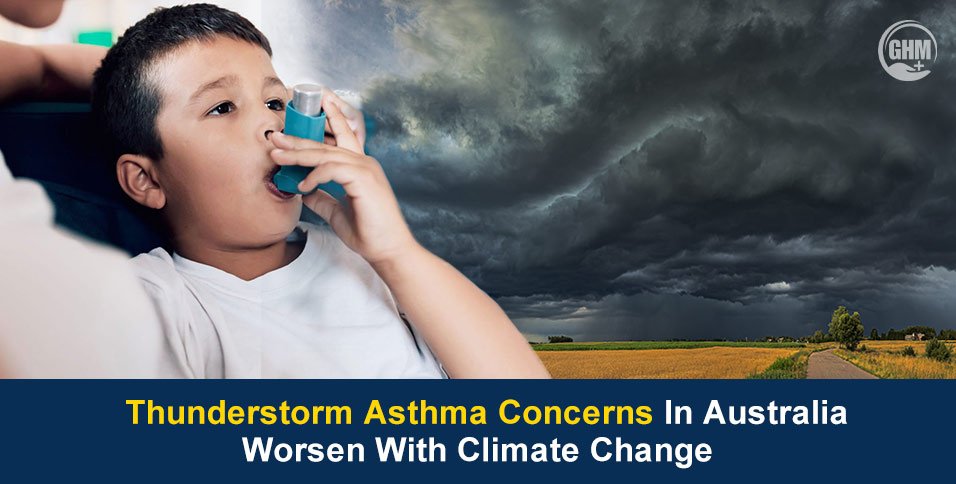Doctors in Australia are warning that climate change is increasing thunderstorm asthma, a condition that strikes suddenly and affects not only asthma sufferers but also those who have never experienced breathing issues before.
With the Bureau of Meteorology (BOM) forecasting a wetter-than-average spring, experts believe that higher levels of grass pollen and other allergens could create the perfect storm for asthma outbreaks in urban areas, raising thunderstorm asthma concerns.
“We know from past events that thunderstorm asthma can overwhelm emergency services and put lives at risk,” says Dr. Karen Miles, a respiratory specialist based in Melbourne. “Climate change is intensifying weather patterns, which means the triggers are becoming harder to control.”
What Is Thunderstorm Asthma?
- Thunderstorm asthma occurs when high pollen counts mix with storm conditions. Strong winds and humidity turn pollen grains into tiny particles, which are then inhaled deeply into the lungs.
- These particles can trigger sudden and severe asthma symptoms, such as shortness of breath, coughing, wheezing, and chest tightness.
- People with asthma, Hay fever (allergic fever) sufferers, and even those with no history of asthma are at risk.
This makes thunderstorm asthma especially dangerous because people may not realize they are vulnerable until symptoms strike.
Why Climate Change Makes It Worse?
Climate change is reshaping Australia’s pollen and weather patterns, which leads to,
1. Longer Pollen Seasons
Warmer temperatures and increased rainfall mean grass grows faster and releases pollen over longer periods. This extends the allergy and asthma risk season.
2. More Intense Storms
Research shows that climate change is causing more severe storms, with high winds and heavy rainfall. These are the perfect conditions to trigger thunderstorm asthma events.
3. Higher Pollen Concentrations
Wetter springs encourage dense vegetation growth in rural areas. Strong winds then carry pollen into urban spaces, exposing millions of city dwellers to allergens, increasing thunderstorm asthma threats.
Looking Back At The 2016 Melbourne Outbreak
The dangers of thunderstorm asthma became widely known after the 2016 Melbourne outbreak, where 10 people died, and thousands were hospitalised, which overwhelmed emergency services.
It was the largest recorded thunderstorm asthma event in the world and a turning point in Australia’s understanding of this phenomenon.
Since then, public health agencies have been working on early warning systems, but doctors say climate change could make such events more frequent and harder to predict, which adds to thunderstorm asthma concerns.
Preparing For The Season Ahead
With wetter-than-average conditions forecast, experts have recommended a few precautions:
1. Stay Informed
- Check pollen and thunderstorm asthma forecasts provided by BOM and health associations.
- Download apps or sign up for SMS alerts in your state.
2. Limit Exposure
- Stay indoors during high-risk storm days.
- Keep windows closed and use air filters where possible.
- Shower and change clothes after being outdoors to remove pollen.
3. Manage Symptoms
- People with asthma should follow their asthma action plan and keep inhalers handy.
- Hay fever sufferers may benefit from antihistamines or nasal sprays, as advised by doctors.
4. Seek Help If Needed
If symptoms escalate, such as difficulty breathing, blue lips, or inability to speak, seek emergency medical care immediately.
Public Health And Climate Action
Thunderstorm asthma is not just a medical issue but also a climate and environmental challenge.
- Healthcare Strain: Sudden asthma outbreaks can overwhelm hospitals.
- Vulnerable Communities: Communities like urban populations, children, and the elderly face higher risks.
- Climate Policy: Addressing air pollution and reducing greenhouse gases can help manage long-term health impacts.
Experts stress that awareness and preparation are key to reducing fatalities. But in the long run, tackling climate change itself is essential to lowering the risks.
“Thunderstorm asthma is a clear example of how environmental change directly affects human health,” says Dr. Miles. “We must treat climate change as a health crisis, not just an environmental one.”
Conclusion
As Australia heads into a wetter spring, thunderstorm asthma concerns are rising. Climate change is fueling longer pollen seasons, stronger storms, and higher allergen levels, making the threat greater than ever.
Doctors urge Australians to stay prepared, whether they suffer from asthma or not, monitor pollen forecasts, and take preventive measures.
In the face of climate change, thunderstorm asthma serves as a stark reminder that our health is closely tied to the health of our environment.



















